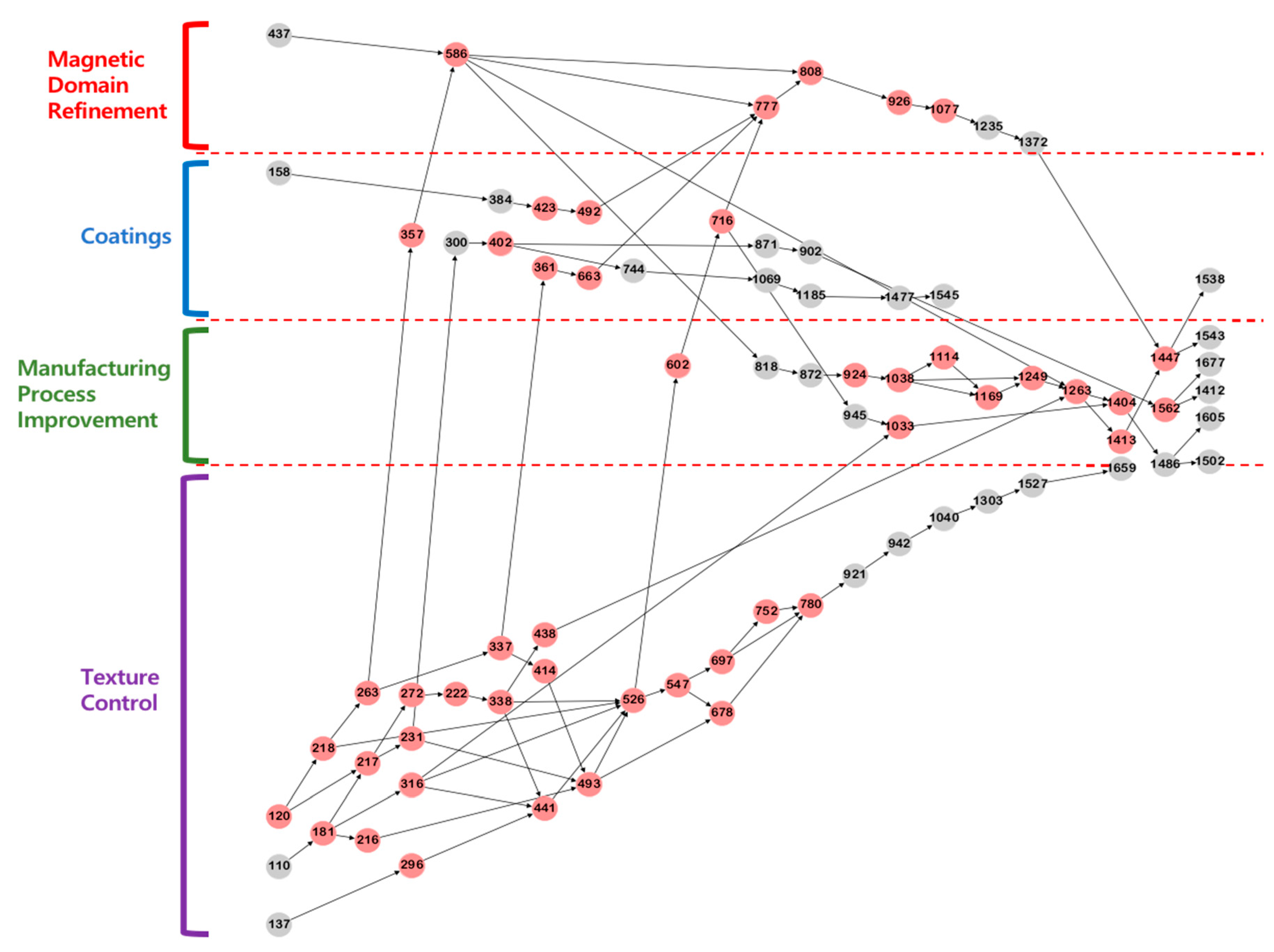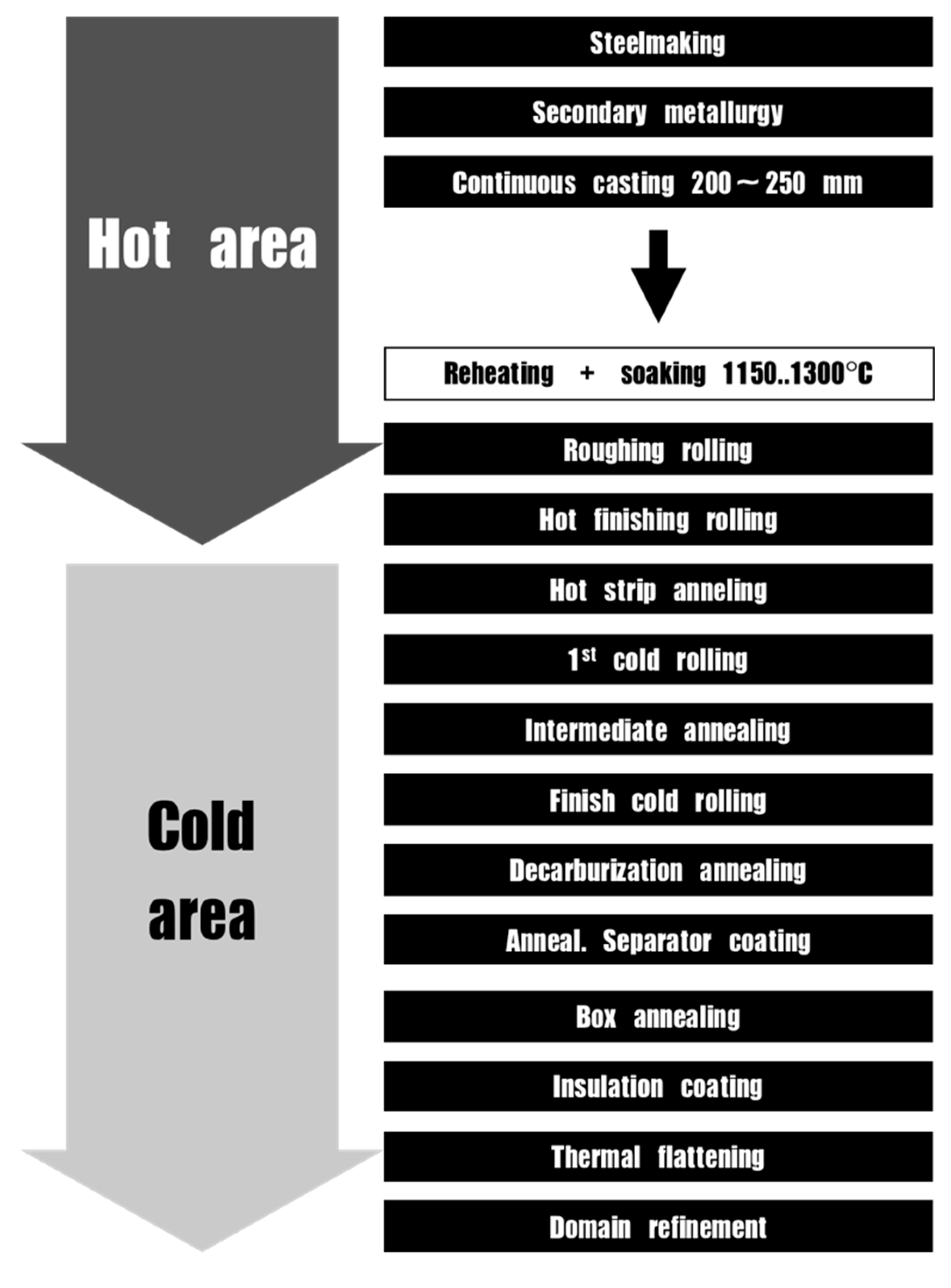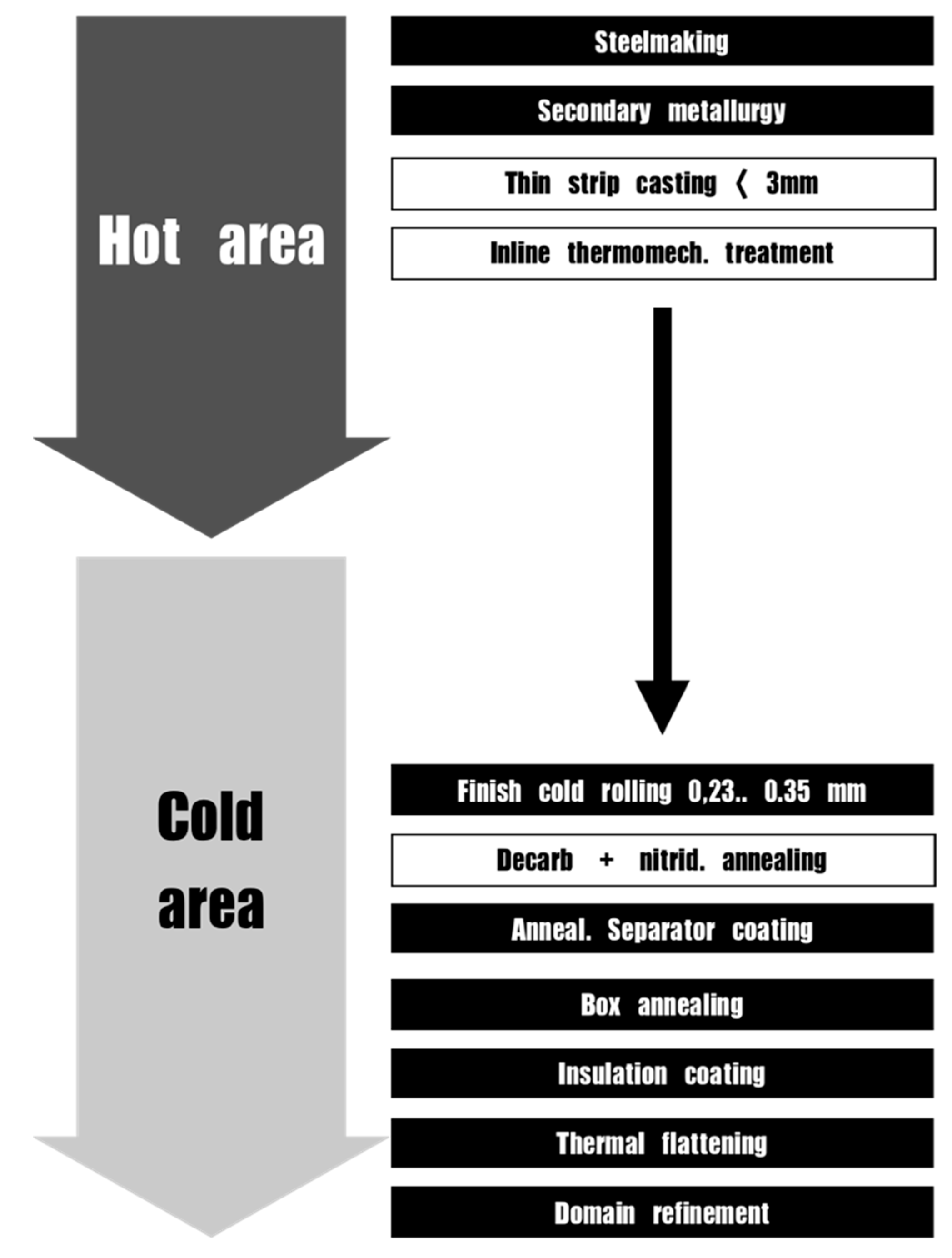Developmental Trajectories in Electrical Steel Technology Using Patent Information
Abstract
1. Introduction
2. Electrical Steel
3. Data
4. Method
4.1. Citation Network
4.2. GBFP Based Main-Path Analysis
4.2.1. Genetic Knowledge Persistence and Its Measurement
- Assign patents to layers to draw lineage structure of the network. Patents without in-domain backward citation is assigned to the first layer. In-domain backward citation refers to backward citation among source patent data which is predefined technology domain. Patents citing the patents in the first layer are assigned to the next layer. Patents without in-domain forward citation becomes the end point (end-layer). The maximum length of lineage structure is determined by the longest link in the structure.
- Measure how much a patent inherited to recently invented patents (end-layer). Value of how much knowledge a parent patent inherited to a child patent in the next layer is calculated by 1/the number of backward citation of a child patent. The knowledge persistence of a patent in entire network is calculate according to the following formula [8]:where calculation of the knowledge persistence of a patent in entire network; KPA is knowledge persistence value of patent A (PA), n is the number of patents in the last layer, which are (indirectly) connected to PA, is all possible backward paths from to PA, is the number of patents on the j-th backward path from to PA, Pijk is the k-th patent on the j-th backward path from to PA and BWDCit(Pijk) is the number of backward citations of Pijk, without considering backward citations by patents in between the first layer and layer t − 1, when PA belongs to layer t.
4.2.2. Identification of Main-Paths
5. Results
Developmental Trajectories of Electrical Steel
6. Conclusions
Author Contributions
Funding
Acknowledgments
Conflicts of Interest
Appendix A. List of High Persistence Patents in the Electric Steel Technology
| Patent Number | Serial Number | Layer | Application Year | Persistence | GP | LP | Number of In-Domain Forward Citations | Title |
|---|---|---|---|---|---|---|---|---|
| US2158065 | 120 | 1 | 1935 | 13.5349 | 0.26566 | 1 | 12 | Art of producing magnetic materials |
| US2599340 | 181 | 2 | 1948 | 50.9471 | 1 | 1 | 25 | Process of increasing the permeability of oriented silicon steels |
| US2867557 | 216 | 3 | 1956 | 24.4019 | 0.47897 | 0.64265 | 20 | Method of producing silicon steel strip |
| US2867559 | 217 | 3 | 1956 | 37.9708 | 0.7453 | 1 | 14 | Method for producing grain oriented silicon steel |
| US2867558 | 218 | 2 | 1956 | 22.082 | 0.43343 | 0.43343 | 19 | Method for producing grain-oriented silicon steel |
| US3164496 | 222 | 5 | 1956 | 40.1215 | 0.78751 | 1 | 7 | Magnetic material and method of fabrication |
| US2992952 | 231 | 4 | 1957 | 31.5646 | 0.61956 | 1 | 17 | Method of manufacturing magnetic sheets |
| US3090711 | 263 | 3 | 1959 | 16.877 | 0.33126 | 0.44447 | 11 | Procedure for secondary recrystallization |
| US2992951 | 272 | 4 | 1960 | 23.1021 | 0.45345 | 0.7319 | 11 | Iron-silicon magnetic sheets |
| US3151005 | 296 | 4 | 1961 | 15.7386 | 0.30892 | 0.49862 | 9 | Method of producing grain-oriented electrical steel |
| US3159511 | 316 | 4 | 1962 | 18.8119 | 0.36924 | 0.59598 | 19 | Process of producing single-oriented silicon steel |
| US3212942 | 337 | 6 | 1963 | 17.4406 | 0.34233 | 0.37347 | 8 | Process for producing double-oriented magnetic steel sheets |
| US3266955 | 338 | 6 | 1963 | 46.6992 | 0.91662 | 1 | 8 | Process for producing silicon steel sheet having (100) plane in the rolling plane |
| US3347718 | 357 | 4 | 1964 | 16.1724 | 0.31743 | 0.51236 | 17 | Method for improving the magnetic properties of ferrous sheets |
| US3379581 | 361 | 7 | 1964 | 17.6283 | 0.34601 | 0.55203 | 7 | Desulfurizing coating for ferrous material and method of using it |
| US3522108 | 402 | 6 | 1967 | 20.8321 | 0.4089 | 0.44609 | 7 | Method of forming electric insulating films on al - containing silicon steel sheet and surface-coated al-containing silicon steel sheet |
| US3513039 | 414 | 7 | 1967 | 21.7535 | 0.42698 | 0.68121 | 1 | Process for reduction of core losses in cube textured iron-silicon alloys |
| US3533861 | 423 | 7 | 1968 | 20.0484 | 0.39351 | 0.62781 | 2 | Method of improving the magnetostriction and core loss of cube-on-face oriented magnetic steels |
| US3636579 | 438 | 7 | 1969 | 19.9658 | 0.39189 | 0.62523 | 20 | Process for heat-treating electromagnetic steel sheets having a high magnetic induction |
| US3632456 | 441 | 7 | 1969 | 31.9337 | 0.6268 | 1 | 21 | Method for producing an electromagnetic steel sheet of a thin sheet thickness having a high-magnetic induction |
| US3856568 | 492 | 8 | 1972 | 16.2183 | 0.31834 | 0.43967 | 13 | Method for forming an insulating film on an oriented silicon steel sheet |
| US3770517 | 493 | 8 | 1972 | 36.8871 | 0.72403 | 1 | 25 | Method of producing substantially non-oriented silicon steel strip by three-stage cold rolling |
| US3855018 | 526 | 9 | 1973 | 28.6369 | 0.56209 | 1 | 9 | Method for producing grain oriented silicon steel comprising copper |
| US3940299 | 547 | 10 | 1974 | 27.2568 | 0.535 | 0.84523 | 21 | Method for producing single-oriented electrical steel sheets having a high magnetic induction |
| US3990923 | 586 | 5 | 1975 | 18.5269 | 0.36365 | 0.46177 | 41 | Method of producing grain oriented electromagnetic steel sheet |
| US4010050 | 602 | 10 | 1975 | 32.2477 | 0.63296 | 1 | 6 | Processing for aluminum nitride inhibited oriented silicon steel |
| US4130447 | 663 | 8 | 1977 | 16.5953 | 0.32574 | 0.44989 | 5 | Annealing separator and steel sheet coated with same |
| US4204890 | 678 | 11 | 1978 | 19.6149 | 0.38501 | 0.59897 | 28 | Method of producing non-oriented silicon steel sheets having an excellent electromagnetic property |
| US4174235 | 697 | 11 | 1978 | 15.3057 | 0.30042 | 0.46738 | 4 | Product and method of producing silicon-iron sheet material employing antimony |
| US4242155 | 716 | 11 | 1979 | 32.7477 | 0.64278 | 1 | 4 | Method of forming an insulating film on a grain-oriented silicon steel sheet |
| US4280856 | 752 | 12 | 1980 | 17.1455 | 0.33654 | 0.56741 | 6 | Method for producing grain-oriented silicon steel sheets having a very high magnetic induction and a low iron loss |
| US4363677 | 777 | 12 | 1981 | 30.217 | 0.59311 | 1 | 18 | Method for treating an electromagnetic steel sheet and an electromagnetic steel sheet having marks of laser-beam irradiation on its surface |
| US4421574 | 780 | 13 | 1981 | 10.2212 | 0.20062 | 0.89756 | 8 | Method for suppressing internal oxidation in steel with antimony addition |
| US4554029 | 808 | 13 | 1982 | 11.3878 | 0.22352 | 1 | 11 | Local heat treatment of electrical steel |
| US4773948 | 924 | 14 | 1987 | 13.1473 | 0.25806 | 1 | 7 | Method of producing silicon iron sheet having excellent soft magnetic properties |
| US4909864 | 926 | 15 | 1987 | 8.6317 | 0.16942 | 0.84359 | 3 | Method of producing extra-low iron loss grain oriented silicon steel sheets |
| US5082509 | 1033 | 15 | 1990 | 10.232 | 0.20084 | 1 | 8 | Method of producing oriented electrical steel sheet having superior magnetic properties |
| US5039359 | 1038 | 15 | 1990 | 9.7086 | 0.19056 | 0.94885 | 6 | Process for producing grain-oriented electrical steel sheet having superior magnetic characteristic |
| US5223048 | 1077 | 16 | 1991 | 7.4268 | 0.14577 | 0.80023 | 6 | Low iron loss grain oriented silicon steel sheets and method of producing the same |
| US5261971 | 1114 | 16 | 1992 | 9.2808 | 0.18217 | 1 | 1 | Process for preparation of grain-oriented electrical steel sheet having superior magnetic properties |
| US5545263 | 1169 | 17 | 1994 | 11.0403 | 0.2167 | 1 | 4 | Process for production of grain oriented electrical steel sheet having superior magnetic properties |
| US5667598 | 1249 | 18 | 1996 | 9.7917 | 0.19219 | 1 | 3 | Production method for grain oriented silicon steel sheet having excellent magnetic characteristics |
| US5885371 | 1263 | 19 | 1997 | 14.5 | 0.28461 | 1 | 13 | Method of producing grain-oriented magnetic steel sheet |
| US6432222 | 1404 | 20 | 2001 | 3.5 | 0.068699 | 1 | 5 | Method for producing a grain-oriented electrical steel sheet excellent in magnetic properties |
| US6444051 | 1413 | 20 | 2001 | 3 | 0.058885 | 0.85714 | 3 | Method of manufacturing a grain-oriented electromagnetic steel sheet |
| US6811619 | 1447 | 21 | 2002 | 2 | 0.039256 | 1 | 2 | Method of manufacturing grain-oriented electrical steel sheets |
| US7377986 | 1562 | 21 | 2006 | 2 | 0.039256 | 1 | 2 | Method for production of non-oriented electrical steel strip |
References
- Oda, Y.; Kohno, M.; Honda, A. Recent development of non-oriented electrical steel sheet for automobile electrical devices. J. Magn. Magn. Mater. 2008, 320, 2430–2435. [Google Scholar] [CrossRef]
- Magdaleno-Adame, S.; Kefalas, T.D.; Garcia-Martinez, S.; Perez-Rojas, C. Electromagnetic Finite Element Analysis of Electrical Steels Combinations in Lamination Core Steps of Single-phase Distribution Transformers. In Proceedings of the 2017 IEEE International Autumn Meeting on Power, Electronics and Computing (ROPEC), Ixtapa, Mexico, 8–10 November 2017; pp. 1–5. [Google Scholar]
- Verspagen, B. Mapping technological trajectories as patent citation networks: A study on the history of fuel cell research. Adv. Complex Syst. 2007, 10, 93–115. [Google Scholar] [CrossRef]
- Martinelli, A. An emerging paradigm or just another trajectory? Understanding the nature of technological changes using engineering heuristics in the telecommunications switching industry. Res. Policy 2012, 41, 414–429. [Google Scholar] [CrossRef]
- Park, H.; Ree, J.J.; Kim, K. Identification of promising patents for technology transfers using TRIZ evolution trends. Expert Syst. Appl. 2013, 40, 736–743. [Google Scholar] [CrossRef]
- Jaffe, A.B.; Trajtenberg, M. Patents, Citations, and Innovations: A Window on the Knowledge Economy; MIT Press: Cambrideg, MA, USA, 2002. [Google Scholar]
- Choi, S.; Park, H. Investigation of strategic changes using patent co-inventor network analysis: The case of samsung electronics. Sustainability 2016, 8, 1315. [Google Scholar] [CrossRef]
- Park, H.; Magee, C.L. Tracing technological development trajectories: A genetic knowledge persistence-based main path approach. PLoS ONE 2017, 12, e0170895. [Google Scholar] [CrossRef] [PubMed]
- Shih, M.-J.; Liu, D.-R.; Hsu, M.-L. Discovering competitive intelligence by mining changes in patent trends. Expert Syst. Appl. 2010, 37, 2882–2890. [Google Scholar] [CrossRef]
- Wang, G.; Guan, J. Measuring science–technology interactions using patent citations and author-inventor links: An exploration analysis from Chinese nanotechnology. J. Nanopart. Res. 2011, 13, 6245–6262. [Google Scholar] [CrossRef]
- Fleming, L. Recombinant uncertainty in technological search. Manag. Sci. 2001, 47, 117–132. [Google Scholar] [CrossRef]
- Fleming, L.; Sorenson, O. Technology as a complex adaptive system: Evidence from patent data. Res. Policy 2001, 30, 1019–1039. [Google Scholar] [CrossRef]
- Benson, C.L.; Magee, C.L. Quantitative determination of technological improvement from patent data. PLoS ONE 2015, 10, e0121635. [Google Scholar] [CrossRef] [PubMed]
- Yoon, J.; Kim, K. Identifying rapidly evolving technological trends for R&D planning using SAO-based semantic patent networks. Scientometrics 2011, 88, 213–228. [Google Scholar]
- Choi, S.; Park, H.; Kang, D.; Lee, J.Y.; Kim, K. An SAO-based text mining approach to building a technology tree for technology planning. Expert Syst. Appl. 2012, 39, 11443–11455. [Google Scholar] [CrossRef]
- Benson, C.L.; Magee, C.L. A hybrid keyword and patent class methodology for selecting relevant sets of patents for a technological field. Scientometrics 2013, 96, 69–82. [Google Scholar] [CrossRef]
- Benson, C.L.; Magee, C.L. Technology structural implications from the extension of a patent search method. Scientometrics 2015, 102, 1965–1985. [Google Scholar] [CrossRef]
- Moses, A. Electrical steels: Past, present and future developments. Phys. Sci. Meas. Instrum. Manag. Educ. 1990, 137, 233–245. [Google Scholar] [CrossRef]
- Petrovic, D.S. Non-oriented electrical steel sheets. Mater. Tehnol. 2010, 44, 317–325. [Google Scholar]
- Magee, C.; Basnet, S.; Funk, J.; Benson, C. Quantitative empirical trends in technical performance. Technol. Forecast. Soc. Chang. 2016, 104, 237–246. [Google Scholar] [CrossRef]
- Martinelli, A.; Nomaler, Ö. Measuring knowledge persistence: A genetic approach to patent citation networks. J. Evol. Econ. 2014, 24, 623–652. [Google Scholar] [CrossRef]
- Xia, Z.; Kang, Y.; Wang, Q. Developments in the production of grain-oriented electrical steel. J. Magn. Magn. Mater. 2008, 320, 3229–3233. [Google Scholar] [CrossRef]
- Günther, K.; Abbruzzese, G.; Fortunati, S.; Ligi, G. Recent Technology Developments in the Production of Grain-Oriented Electrical Steel. Steel Res. Int. 2005, 76, 413–421. [Google Scholar] [CrossRef]
- Matsuo, M. Texture control in the production of grain oriented silicon steels. ISIJ Int. 1989, 29, 809–827. [Google Scholar] [CrossRef]
- Siebert, R.; Schneider, J.; Beyer, E. Laser cutting and mechanical cutting of electrical steels and its effect on the magnetic properties. IEEE Trans. Magn. 2014, 50, 1–4. [Google Scholar] [CrossRef]
- Iuchi, T.; Yamaguchi, S.; Ichiyama, T.; Nakamura, M.; Ishimoto, T.; Kuroki, K. Laser processing for reducing core loss of grain oriented silicon steel. J. Appl. Phys. 1982, 53, 2410–2412. [Google Scholar] [CrossRef]
- Washko, S.; Choby, E. Evidence for the effectiveness of stress coatings in improving the magnetic properties of high permeability 3% Si-Fe. IEEE Trans. Magn. 1979, 15, 1586–1591. [Google Scholar] [CrossRef]
- Littmann, M. Iron and silicon-iron alloys. IEEE Trans. Magn. 1971, 7, 48–60. [Google Scholar] [CrossRef]
- Cole, G. Grain-oriented iron-silicon alloys. Electr. Eng. 1953, 72, 411–416. [Google Scholar] [CrossRef]
- Kubota, T. Recent Progress on Non-oriented Silicon Steel. Steel Res. Int. 2005, 76, 464–470. [Google Scholar] [CrossRef]





| # of patents | 1681 |
| Period (Application date) | 1 January 1834~31 December 2013 |
| Search query | UPC: (((148/110) OR (148/111) OR (148/112) OR (148/120) OR (148/121) OR (148/122) OR (148/306) OR (148/307) OR (148/308) OR (148/309)) NOT (420/89)) AND IPC: (((C22C38) OR (H01F1) OR (C21D1) OR (C21D8) OR (C21D9)) NOT (H01f1/2)) |
| Sub-Domain (Techniques) | Major Effect | Value to the Core Market |
|---|---|---|
| Magnetic domain refinement | Core loss | Performance efficiency |
| Coatings | Core loss | Performance efficiency |
| Improvement of manufacturing process | Reduction of manufacturing cost and time | Low cost |
| Texture control | Core loss and high permeability | Performance efficiency |
| Conventional Grades | High Permeability Grades | ||
|---|---|---|---|
| Type No.1 | Type No. 2 | Type No. 3 | |
| Steelmaking | Steelmaking | Steelmaking | Steelmaking |
| Microalloy (MnS) | Microalloy (AlN + MnS) | Microalloy (MnS + Sb, Mo) | Microalloy (B + N + S or Se) |
| Hot rolling | Hot rolling | Hot rolling | Hot rolling |
| Reheating (1593 K) | Reheating (1633 K) | Reheating (1593 K) | Reheating (1523 K) |
| Annealing (1073~1273 K) | Annealing (1373 K) | Annealing (1173 K) | Annealing (1148~1298 K) |
| Cold rolling (70%) | Cold rolling (87%) | Cold rolling | Cold rolling (80%) |
| Annealing (1073~1273 K) | Annealing | ||
| Cold rolling (55%) | Cold rolling (65%) | ||
| Decarburizing (1073 K, wet ) | Decarburizing | Decarburizing | Decarburizing |
| Box annealing (1473 K, dry ) | Box annealing (1473 K) | Box annealing (1093~1173 K, then 1473 K, dry ) | Box annealing (1473 K) |
© 2018 by the authors. Licensee MDPI, Basel, Switzerland. This article is an open access article distributed under the terms and conditions of the Creative Commons Attribution (CC BY) license (http://creativecommons.org/licenses/by/4.0/).
Share and Cite
You, D.; Park, H. Developmental Trajectories in Electrical Steel Technology Using Patent Information. Sustainability 2018, 10, 2728. https://doi.org/10.3390/su10082728
You D, Park H. Developmental Trajectories in Electrical Steel Technology Using Patent Information. Sustainability. 2018; 10(8):2728. https://doi.org/10.3390/su10082728
Chicago/Turabian StyleYou, Donghyun, and Hyunseok Park. 2018. "Developmental Trajectories in Electrical Steel Technology Using Patent Information" Sustainability 10, no. 8: 2728. https://doi.org/10.3390/su10082728
APA StyleYou, D., & Park, H. (2018). Developmental Trajectories in Electrical Steel Technology Using Patent Information. Sustainability, 10(8), 2728. https://doi.org/10.3390/su10082728




